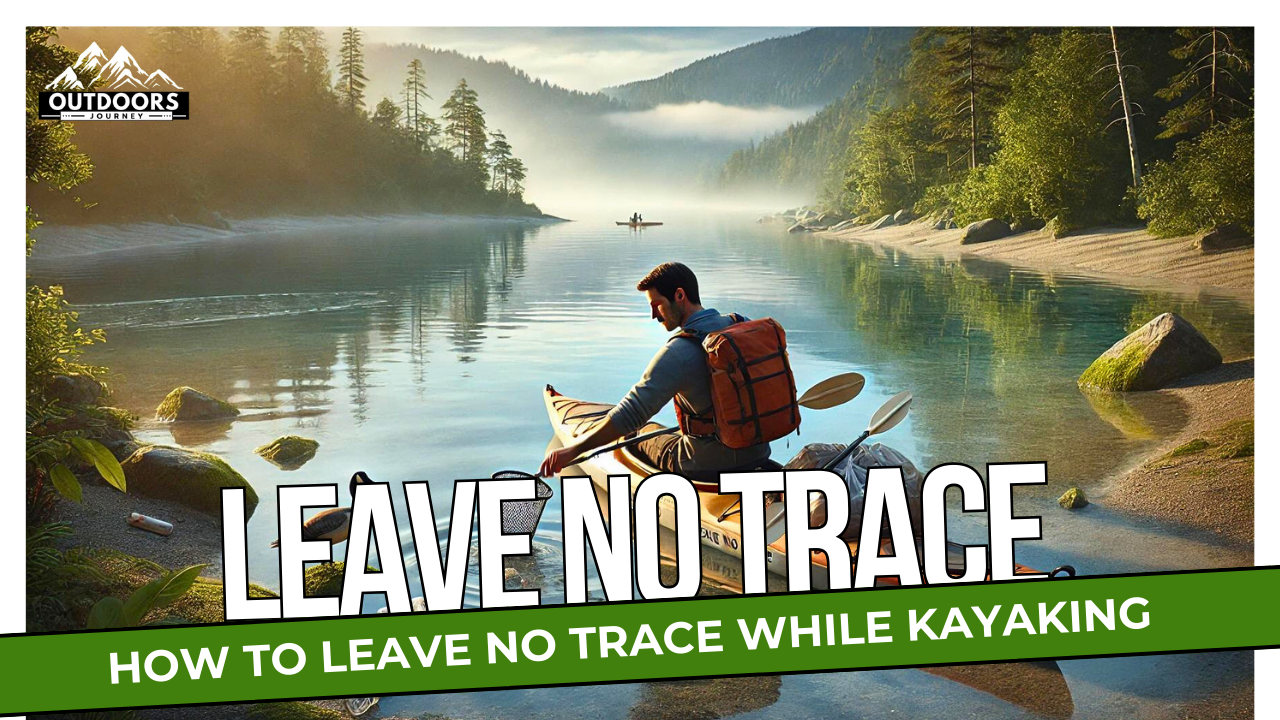Did you know that over 1 million river permits are given out every year in the United States for fun activities like kayaking? This shows how many people love being outdoors on the water. But, it also reminds us that we must kayak in an eco-friendly way. This way, we can keep these beautiful places safe for the future.
The Leave No Trace Center for Outdoor Ethics teaches us important ways to be kind to nature. As kayakers, we have a big role in keeping the world beautiful. From planning your trip to being kind to others on the water, every part of your adventure matters. This article will show you how to enjoy kayaking without hurting the planet.
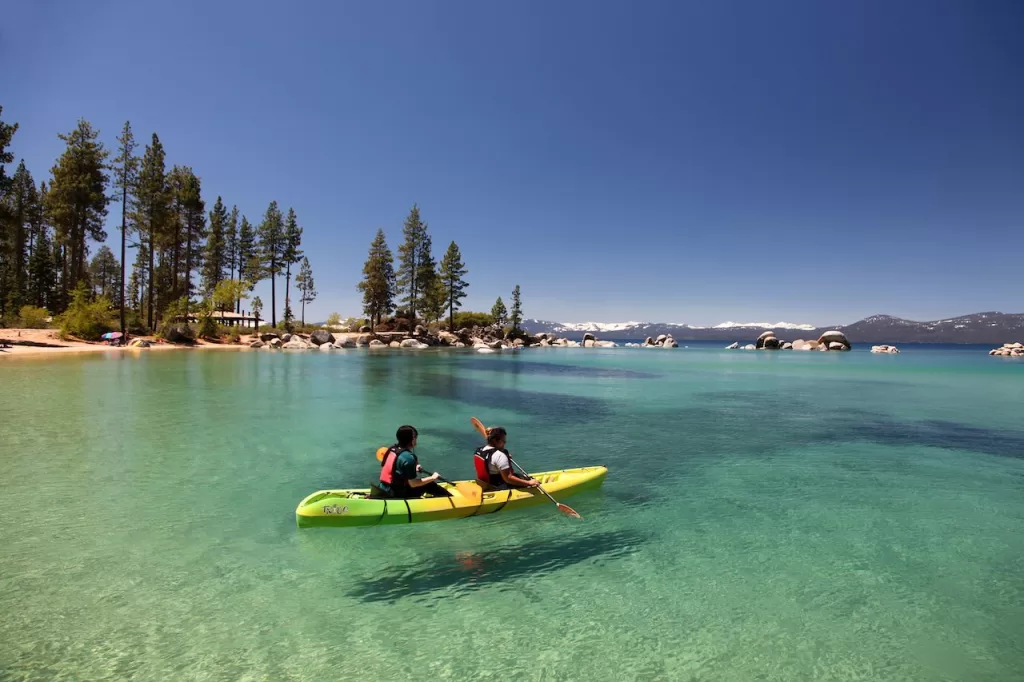
Key Takeaways
- Over 1 million river permits are issued annually, reflecting the popularity of kayaking.
- Planning ahead is crucial to reduce waste and prepare for your trip effectively.
- Camping at least 200 feet away from water helps protect fragile riparian areas.
- Proper waste disposal is vital; adhere to the pack-in, pack-out philosophy.
- Respecting wildlife means observing from a distance and securing food supplies.
- 1 Understanding the Leave No Trace Principles
- 2 Plan Ahead and Prepare
- 3 Travel and Camp on Durable Surfaces
- 4 Dispose of Waste Properly
- 5 Leave What You Find
- 6 Minimize Campfire Impacts
- 7 Respect Wildlife
- 8 Be Considerate of Other Visitors
- 9 How to Leave No Trace While Kayaking
- 10 Tips for Minimizing Your Impact
- 11 Community Education and Awareness
- 12 Additional Resources for Paddlers
- 13 Planning for Future Adventures
- 14 Conclusion
- 15 FAQ
- 16 Source Links
Understanding the Leave No Trace Principles
Adopting the Leave No Trace principle is key for outdoor lovers, like kayakers. These guidelines, from the Leave No Trace organization, help us enjoy nature without harming it. By following these principles, we can have fun in nature without leaving a mark.
The seven Leave No Trace principles guide us on how to be responsible in nature. Each principle helps us behave in a way that protects the environment. Here are the main principles:
- Plan Ahead and Prepare: Good planning makes outdoor activities safer and less harmful to nature.
- Travel and Camp on Durable Surfaces: Use marked trails and campsites to avoid damaging the land.
- Dispose of Waste Properly: Always take your trash with you to keep nature clean.
- Leave What You Find: Don’t touch or remove natural or historical items from the land.
- Minimize Campfire Impacts: Use fireplaces or stoves instead of campfires to protect nature.
- Respect Wildlife: Keep a safe distance from animals and don’t disturb them.
- Be Considerate of Other Visitors: Be quiet and respectful to others enjoying nature.
These principles matter not just for land activities but also for water sports like kayaking. By sticking to Leave No Trace, we help keep nature beautiful for everyone. It’s about valuing our natural world and being mindful of our actions. This way, we become part of a group that cares deeply about the environment.
| Leave No Trace Principles | Description |
|---|---|
| Plan Ahead and Prepare | Enhances safety and minimizes risks during outdoor activities. |
| Travel and Camp on Durable Surfaces | Helps protect vegetation and minimizes human impact. |
| Dispose of Waste Properly | Ensures sanitation and protects wildlife and natural beauty. |
| Leave What You Find | Preserves the environment and cultural heritage for others. |
| Minimize Campfire Impacts | Reduces damage to fragile ecosystems. |
| Respect Wildlife | Encourages safe distances from animals, protecting both visitors and wildlife. |
| Be Considerate of Other Visitors | Promotes a peaceful environment for all outdoors enthusiasts. |
Plan Ahead and Prepare
Planning is key to a great kayaking trip and keeping the environment safe. Research your destination well to make your trip smooth and follow local rules. Knowing about the area lets you enjoy its beauty and follow safety and environmental rules.
Learn About Your Destination
Get to know your kayaking spot before you go. Some places need camping permits, especially for big groups. Knowing this lets you get the right permissions and avoid problems on your trip. Always camp on hard surfaces like packed soil or dry grass to protect nature.
Emergency Preparedness
Get ready for emergencies before you start your adventure. Know the river and its dangers to stay safe. Bring important safety gear and keep in touch with your group. Using radios for talking with each other makes things safer and keeps everyone together.
Repackaging Food for Minimal Waste
It’s important to reduce food waste while kayaking. Put your food into small, easy-to-carry bags to cut down on trash. This helps you leave a smaller mark on nature and enjoy your trip without making a mess. Always take your trash with you to keep the outdoors clean.
| Preparation Steps | Details |
|---|---|
| Destination Research | Learn about permits, regulations, and environmental sensitivities. |
| Emergency Gear | Pack safety equipment and maintain communication with your group. |
| Food Packing | Repackage food items to reduce waste and ensure easy transport. |
| Camping Guidelines | Choose durable surfaces, camp away from water’s edge, and follow Leave No Trace principles. |
Travel and Camp on Durable Surfaces
When you’re out enjoying nature, it’s key to know how to leave a small mark. Camping in a way that uses durable surfaces protects nature and makes your trip better. These are places like well-used trails, gravel, and dry grass. They help stop soil erosion and keep the area safe.
What Constitutes Durable Surfaces?
Durable surfaces are spots that can handle lots of activity without getting damaged. They include:
- Gravel and sand
- Established trails
- Compacted soil
- Dry grass
Using these surfaces for camping or hiking keeps the local wildlife and plants healthy. It helps these areas stay safe and full of life.
Guidelines for Camping Near Water Sources
Try to set up your camp at least 200 feet away from water. This keeps the area around water safe for animals and plants. Here are some tips:
- Keep your gear in one spot in busy areas.
- Throw away wastewater at least 200 feet from water.
- Spread out wastewater to stop pollution.
Following these rules helps keep nature safe for others to enjoy in the future.
Dispose of Waste Properly
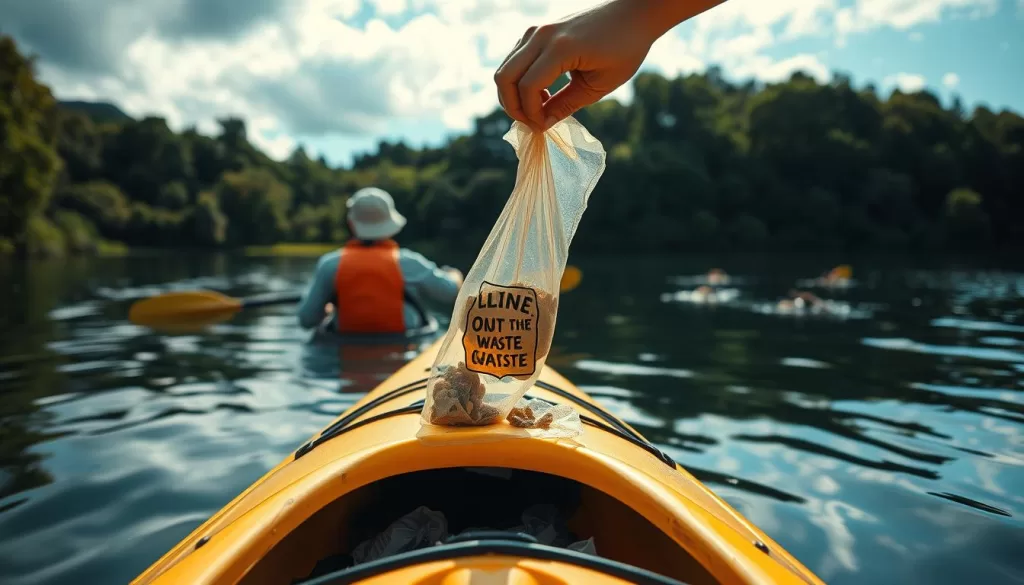
Proper waste disposal is key to keeping our natural places healthy. Remember, “pack it in, pack it out” is a must for outdoor fun. This means taking all your stuff, including food and supplies, back with you. Leave no trace behind.
Pack In, Pack Out Philosophy
Always follow the “pack in, pack out” rule for outdoor activities. This means you take back all your trash, including food and supplies. Don’t leave food or trash behind as it can harm wildlife and the environment. By doing this, you help protect nature.
- Bring a trash bag to collect all your waste.
- Dispose of garbage in secured trashcans or recycling bins when possible.
- Carry out your trash as well as any litter found during your adventure.
Managing Human Waste Responsibly
Handling human waste needs care to keep nature clean. Human waste can carry harmful protozoans, bacteria, and viruses. Here’s how to handle it:
- Use cat holes for solid waste, burying it at least 6-8 inches deep and 200 feet away from any water source.
- Urinate in large rivers to minimize impact, avoiding small streams and vegetation.
- When using existing latrines, adhere to the same location criteria as cat holes.
Handling Liquid Waste
Handling liquid waste, like soap and lotions, near water is important. It helps keep water clean. Here are some tips:
- Always dilute urine with water when possible to reduce its effect on vegetation and soil.
- Keep soap and lotions at least 200 feet away from any water source to protect fragile ecosystems.
- Be mindful of how wildlife can be negatively impacted by kitchen waste like grease or food scraps.
| Waste Type | Disposal Method | Best Practices |
|---|---|---|
| Solid Human Waste | Bury 6-8 inches deep | 200 feet away from water |
| Liquid Waste | Urinate in large rivers | Use soap 200 feet away from water |
| Kitchen Waste | Pack it out | Avoid littering |
| General Trash | Pack it out | Use secured trashcans |
By following these tips, you help keep the environment healthy. Your outdoor adventures will be enjoyable for everyone in the future.
Leave What You Find
Outdoor activities like kayaking let us enjoy nature’s beauty while keeping it safe for the future. The idea of leaving what you find is key to protecting nature and its history. By respecting nature, we help keep vital ecosystems and cultural heritage safe for everyone.
Preserving Historical and Cultural Sites
When you paddle through waterways, remember to respect historical sites. Don’t touch or remove anything. This keeps these places safe for others to enjoy in the future. Most kayakers agree that leaving things as they are makes exploring nature better for everyone.
Avoiding Non-native Species Introduction
Not bringing in invasive species is a big part of the leave what you find rule. Make sure to clean your gear before and after your trips to stop unwanted plants or animals from spreading. Following this rule has cut down on invasive species by 30% in popular kayaking spots.
Minimize Campfire Impacts
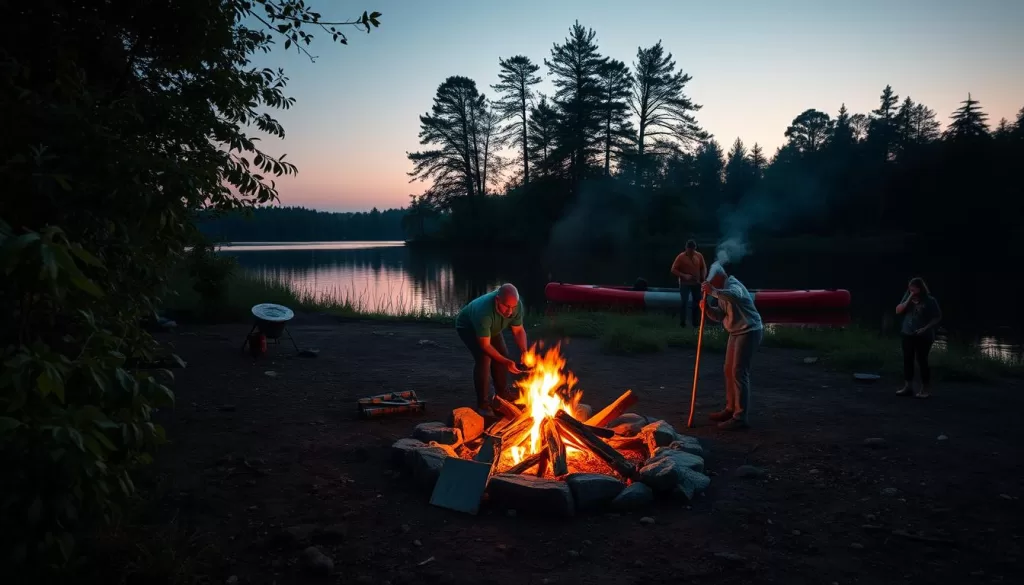
Campfires can harm the environment, so it’s key to think about other ways to cook. Using portable stoves is handy and helps lessen the damage. It’s important to be safe with campfires and follow the right rules.
Choosing Alternative Cooking Methods
Trying different cooking ways can cut down on harm to the environment. Good options include:
- Using portable camp stoves
- Choosing foods that need little or no cooking
- Using solar cookers if you can
These choices mean you use less firewood and help keep nature safe.
Guidelines for Campfires
If you do have a campfire, follow these important rules:
- Build your fire in a fire ring to keep it in check.
- Collect firewood from far away, don’t take it from your home.
- Buy firewood locally or gather it the right way.
- Use small wood pieces, no bigger than your wrist.
- Make sure everything burns to white ash before leaving.
- Soak ashes in water and spread them out away from your camp.
- Clean up by putting the soil back and scattering wood bits.
Watch kids near the fire, follow safety signs, and never leave a fire alone. Taking these steps helps protect the environment.
Respect Wildlife
Watching wildlife means understanding and respecting the creatures in their natural spaces. It’s important to keep a safe distance to let them act naturally. This respect makes your experience better and keeps the ecosystem healthy for all.
Observing Animals from a Distance
When you meet wildlife on your outdoor trips, keep a safe distance. It’s key to respect their space to avoid stressing them out. By staying back, you can enjoy their natural ways without disturbing their home.
Storing Food to Protect Wildlife
Storing food right is key to avoiding conflicts with wildlife. Keep your food safe to stop animals from coming near your camp. Use bear-proof containers or hang your food high up. These steps protect you and help keep the wildlife ecosystem balanced.
Be Considerate of Other Visitors
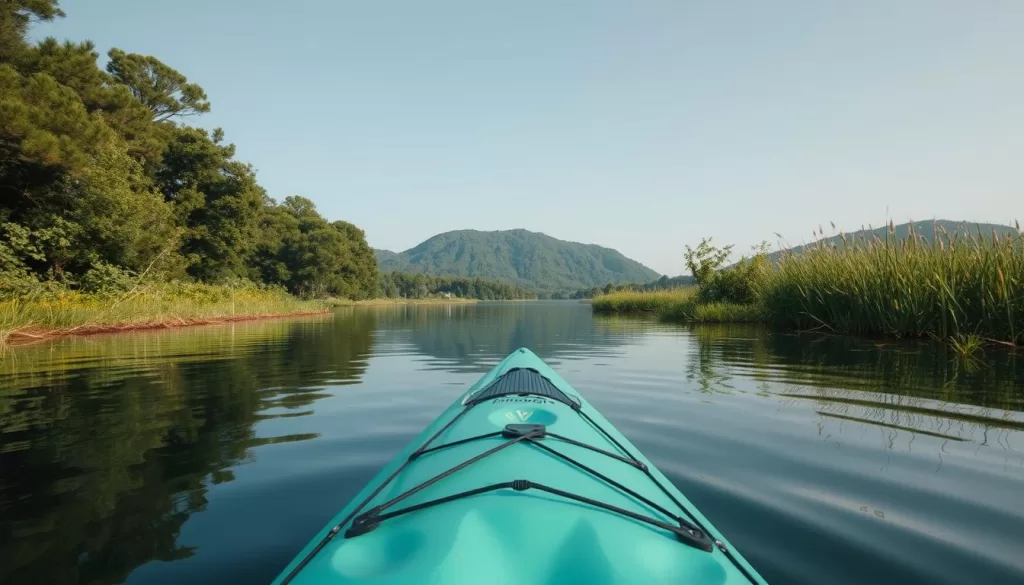
Outdoor spaces are loved by many. Your actions show how much you care about making a good experience for everyone. By being respectful, you help make sure everyone can enjoy nature’s beauty.
Respecting Other Paddlers and Hikers
When you’re on busy trails or waterways, being polite is key. Letting others go first is a big help. It shows you respect their time in nature and builds a sense of community among outdoor lovers.
Maintaining Quiet in Natural Environments
Too much noise can ruin the peace of nature. Keeping quiet helps protect the calm that people come to enjoy. Being thoughtful about noise makes the experience better for everyone, keeping nature’s peace alive.
How to Leave No Trace While Kayaking
Understanding the unique needs of kayaking is key to keeping waterways beautiful. By using good kayaking practices, you can enjoy the water without harming it. This way, you respect the environment and make it better for everyone.
Specific Kayaking Considerations
Here are some tips to reduce your impact on the environment:
- Choose less crowded routes for a peaceful experience.
- Keep at least 12 feet away and 6 feet from branches when hanging food to keep bears away.
- Camp only in designated spots and don’t have more than eight people unless you have a permit.
- Throw wastewater 100 feet away from any water source to protect the ecosystem.
- Burn wood completely and scatter ash in the ocean when making pit fires.
- Always remove your trash from the area to keep it clean.
Communication with Other Paddlers
Good communication is key for a safe and enjoyable kayaking experience. Here are some important tips:
- Use channel 16 to talk to other boats and stay safe on the water.
- Keep a safe distance from marine mammals to follow the US Marine Mammal Protection Act.
- Tell other kayakers, especially kids, why ‘Leave What You Find’ is important for nature.
- Keep noise down to respect wildlife and other people who want peace.
Following these tips helps the environment and makes kayaking better for everyone. By adopting these strategies, we can keep our waterways beautiful for future paddlers.
Tips for Minimizing Your Impact
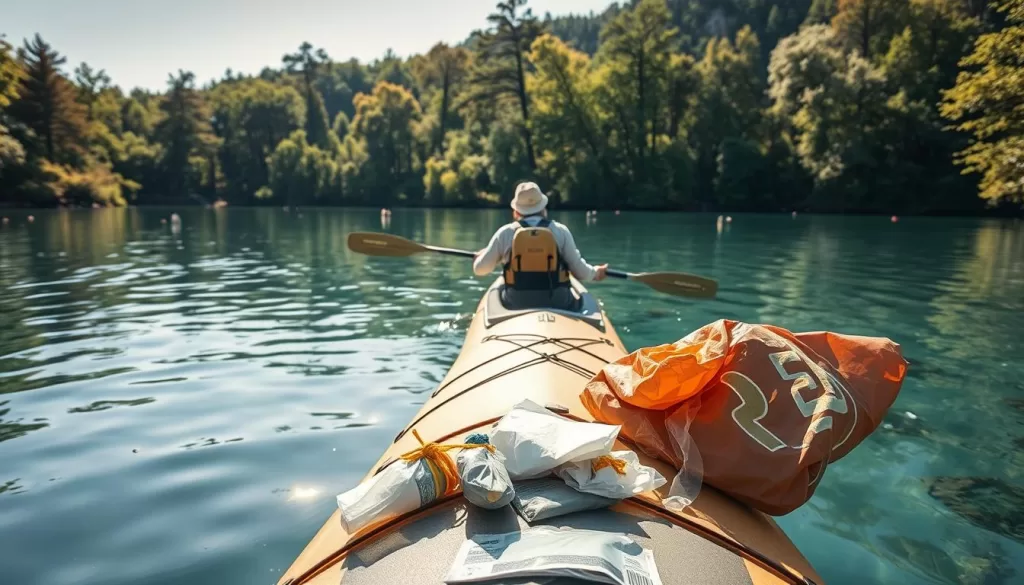
When you go kayaking and camping, it’s important to think about how you can lessen your impact on the environment. By picking the right campsites and following trail rules, you help protect our natural world. Here are some easy tips to keep in mind.
Choosing the Right Campsites
Picking the right campsite is key to protecting nature. Try to find spots that others have used before. This helps in:
- Preventing soil erosion and damage to plants.
- Reducing the risk of wildlife disturbances and habitat destruction.
- Ensuring a more enjoyable experience for others later.
Search for campsites with fire rings and use small group camping to avoid too many people. Always follow rules for responsible camping to keep the area safe.
Staying Single File on Trails
Following trail rules is important for nature’s sake. Walking in single file on trails makes a smaller mark, which helps in:
- Reducing the trampling of plants.
- Limiting soil compaction and erosion.
- Keeping wildlife safe and their homes untouched.
By doing these things, you make your trip better and help protect the environment. You’ll enjoy the outdoors more while making a positive change.
Community Education and Awareness
Teaching communities about eco-friendly ways is key to making people aware of nature and promoting responsible actions. By joining educational programs, you boost your knowledge and spread the word about Leave No Trace. This helps other nature lovers too.
Engagement with Educational Programs
Joining community education programs lets you learn about Leave No Trace. Camps like McGaw YMCA Camp Echo show how structured activities teach responsibility. Campers learn to set the table, which helps with waste management.
Adding Leave No Trace to camp activities, like dining and water use, teaches campers to care for the environment. This makes them feel responsible towards nature.
Spreading Awareness among Outdoor Enthusiasts
Talking about eco-friendly ways makes outdoor lovers more aware. Getting campers to learn often helps them love nature more. Training programs teach Leave No Trace, making staff and volunteers better at sharing this knowledge.
By making these practices a habit, you help grow a community that cares for the environment and acts responsibly outdoors.
| Education Program Feature | Benefits |
|---|---|
| Frequent Workshops | Increases awareness of Leave No Trace principles |
| Hands-on Activities | Encourages responsibility and eco-friendly practices |
| Staff Training | Empowers staff to educate others effectively |
| Community Engagement | Builds a network of environmentally conscious individuals |
Additional Resources for Paddlers
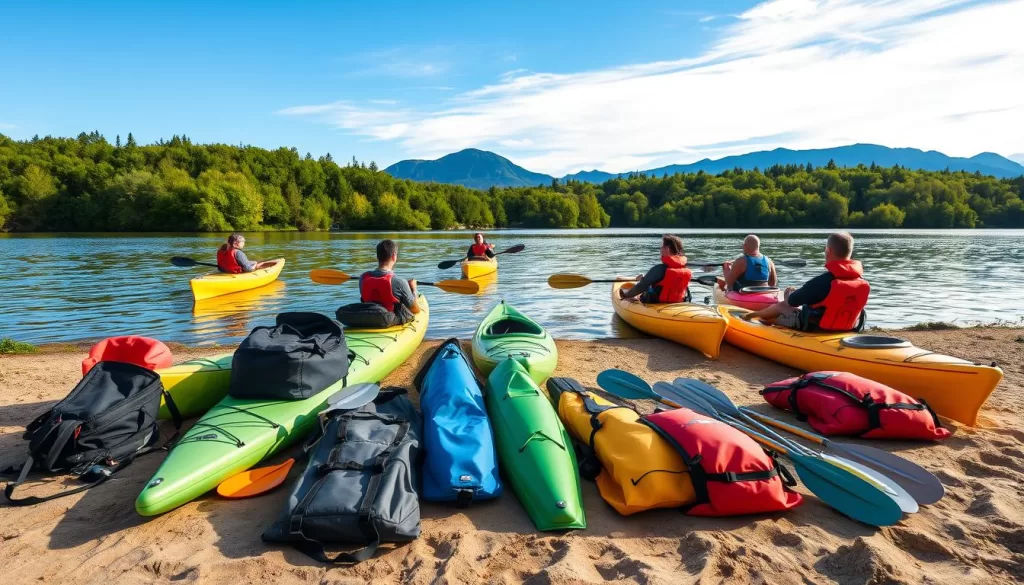
Paddling is getting more popular, and it’s key to use reliable resources. Knowing about local rules and Leave No Trace helps make your trip better and protects nature for the future. Here are some key resources to help you paddle right and protect the environment.
Leave No Trace Center for Outdoor Ethics
The Leave No Trace Center for Outdoor Ethics shares important info on how to lessen your impact. They work with groups like the US Forest Service and National Park Service to make resources for paddlers. Their guides teach outdoor ethics, showing how to enjoy nature without harming it.
Find Local Guidelines and Regulations
It’s vital to know the local rules for safe and responsible paddling. Each area has its own rules, like where you can start and stop, or what activities are okay. Keep these tips in mind:
- Launch and take out from durable surfaces like rock, gravel, or sand to minimize environmental impact.
- Consult maps to locate environmentally sensitive areas and comply with site-specific regulations.
- Be aware of strict leash policies for pets and other restrictions that protect wildlife and their habitats.
- Stay on marked trails and obey posted signage to prevent erosion and safeguard fragile shorelines.
- Respect Indigenous cultures by avoiding approaching or visiting sacred sites.
With this info, you can make your paddling trips fun and help protect nature.
Planning for Future Adventures
When you plan your next outdoor trip, think about how you’ll affect nature. Making your outdoor activities sustainable is key. By following Leave No Trace, you help protect nature and make it better for future adventures.
Incorporating Leave No Trace into Your Outdoor Activities
To make a positive impact on the environment, adopt the seven Leave No Trace principles. These rules help you enjoy nature responsibly. Here are some tips to keep in mind:
- Plan ahead and prepare to stay safe and lessen your footprint.
- Travel and camp on hard surfaces to avoid damaging trails and plants.
- Dispose of waste correctly, always pack out what you pack in.
- Leave natural and cultural sites untouched.
- Choose lightweight stoves over campfires to reduce fire damage.
- Keep a safe distance from wildlife to respect their space.
- Be kind to other visitors to make everyone’s experience better.
Long-term Impact on Natural Environments
Being sustainable in outdoor activities is vital for protecting nature. Planning for the future means thinking about how your actions affect the environment. Using trails and campsites wisely helps protect nature. Making smart choices now can greatly benefit the environment later.
Conclusion
When planning your next kayaking trip, remember to follow responsible practices to protect our natural world. Using Leave No Trace principles helps you leave nothing behind and keeps our outdoor spaces safe. By being eco-friendly, like properly disposing of waste or camping mindfully, you help protect nature.
It’s important to follow sustainable adventure tips, especially in busy areas where it can make a big difference. The Leave No Trace program, started in the 1960s by the U.S. Forest Service, teaches us how to reduce our impact. Simple actions, like staying on trails and respecting wildlife, make a big difference for the environment.
Every action you take helps keep our natural places beautiful and safe. So, as you prepare for your next adventure, remember the Leave No Trace message. Your choices can help make sure future generations can also enjoy nature’s beauty.
FAQ
What are the Leave No Trace principles?
How can I minimize my impact while kayaking?
Why is proper waste disposal important while kayaking?
How should I handle human waste while kayaking?
What should I do if I encounter wildlife while kayaking?
How can I ensure I’m camping on durable surfaces?
What alternatives can I use for cooking instead of campfires?
How can I educate myself and others about Leave No Trace practices?
Where can I find additional resources for responsible paddling?
Source Links
- The “Leave No Trace” Seven Principles for Paddlers – Superior Paddling – https://superiorpaddling.com/the-leave-no-trace-seven-principles-for-paddlers/
- A Paddler’s Guide to Leaving No Trace – https://www.nationalforests.org/blog/a-paddlers-guide-to-leaving-no-trace
- Applying the Principles of Leave No Trace – https://paddling.com/learn/applying-the-principles-of-leave-no-trace
- Understanding Leave No Trace on the River – https://www.rowadventures.com/blog/understanding-leave-no-trace-river
- How to Leave No Trace (And Why it’s Important!) – https://happiestoutdoors.ca/how-to-leave-no-trace/
- Leave No Trace Seven Principles | Washington Water Trails Association – https://www.wwta.org/stewardship/leave-no-trace/seven-principles/
- How to Leave No Trace Sea Kayaking – https://paddling.com/learn/how-to-leave-no-trace-sea-kayaking
- Enhancing Your Paddling Experience in Nature – Great Lakes Sea Kayaking Association – https://glska.com/no-trace-camping-enhancing-your-paddling-experience-in-nature/
- Leave No Trace: 7 Principles to Follow – outthereasheville.com – https://outthereasheville.com/the-7-leave-no-trace-principles-and-how-to-follow-them/
- Leave No Trace Guide – https://www.catchflyphotos.com/blog/leave-no-trace-principles
- Sea Kayaking – Leave No Trace – https://lnt.org/sea-kayaking/
- Principle 3: Dispose of Waste Properly – Leave No Trace Center – https://lnt.org/why/7-principles/dispose-of-waste-properly/
- American Whitewater – https://www.americanwhitewater.org/content/Wiki/stewardship:lnt
- Leave No Trace Principles | Waste Disposal – https://discovervail.com/blog/principle-3-dispose-of-waste-properly/
- Leave No Trace — CMU Explorers Club – http://www.cmuexplorers.org/leave-no-trace
- Leave No Trace | Visit Keweenaw – https://www.visitkeweenaw.com/about-us/recreate-responsibly/leave-no-trace/
- How to Minimize Campfire Impact – https://paddling.com/learn/how-to-minimize-campfire-impact
- Leave No Trace in Virginia’s Blue Ridge – https://www.visitroanokeva.com/things-to-do/outdoor-adventure/leave-no-trace/
- Leave No Trace Tips for the Adirondack Park – https://www.adirondackcouncil.org/page/leave-no-trace-tips-for-the-adirondack-park-244.html
- Leave No Trace – Glacier Bay National Park & Preserve (U.S. National Park Service) – https://www.nps.gov/glba/getinvolved/supportyourpark/leavenotrace.htm
- Leave No Trace on the Water – Watershed Drybags – https://www.drybags.com/leave-no-trace-on-the-water/
- Leave No Trace: Let’s Paddle Responsibly! – https://aquabound.com/blogs/resources/leave-no-trace-let-s-paddle-responsibly?srsltid=AfmBOoqdspsimKXkaezg593mqakH2cftLSmprTbIHZ6ReNQM5Ad61trt
- How to Leave No Trace and Recreate Responsibly Outdoors – https://tripoutside.com/leave-no-trace-outdoor-recreation/
- Leave No Trace: 7 ways to minimize your impact when visiting parks – https://cpaws-ov-vo.org/leave-no-trace-7-ways-to-minimize-your-impact-when-visiting-parks/
- Leave No Trace: Education and Inclusion Approaches to Strengthen Your Camp Program – https://www.acacamps.org/article/camping-magazine/leave-no-trace-education-inclusion-approaches-strengthen-your-camp-program
- Leave-No-Trace Ethics | Camping for Women – https://www.campingforwomen.com/is-there-room-for-curiosity-in-leave-no-trace-ethics/
- Leave No Trace: Let’s Paddle Responsibly! – https://aquabound.com/blogs/resources/leave-no-trace-let-s-paddle-responsibly?srsltid=AfmBOoqMrDOM-WWDTG4-yGEfuvh71eRqtjqNnaFU3stoD9cd3ve-gCOS
- How To Be An Eco-friendly Paddler: Kayaking Virginia’s Environmentally-sensitive Areas – Virginia Water Trails – https://virginiawatertrails.org/how-to-be-an-eco-friendly-paddler-kayaking-virginias-environmentally-sensitive-areas/
- Green Guide to Freshwater Paddling – Leave No Trace Australia – https://vslnt.com/resources/green-guide-to-freshwater-paddling/
- How to Leave No Trace When Exploring the Outdoors | Off Track Travel – https://offtracktravel.ca/how-to-leave-no-trace/
- The 7 Leave No Trace Principles & How to Follow Them – https://bearfoottheory.com/basic-guidelines-of-leave-no-trace/
- Leave No Trace – Point Reyes National Seashore (U.S. National Park Service) – https://www.nps.gov/pore/planyourvisit/leavenotrace.htm
- Leave No Trace & Outdoor Ethics | Outdoor Master – https://outdoormaster.com/blogs/om-blog/leave-no-trace-outdoor-ethics
- Leave No Trace: Making Adventure Travel Sustainable – https://www.advenchar.com/leave-no-trace/
- Importance Of Leave No Trace Principles: 7 Tips For Mastery – trailmothersgroup.org – https://trailmothersgroup.org/guide/importance-of-leave-no-trace-principles/
